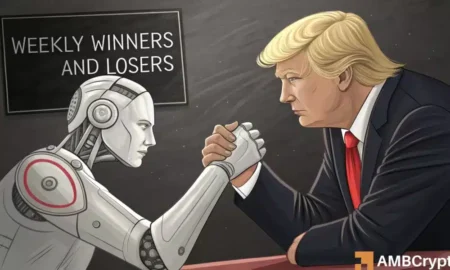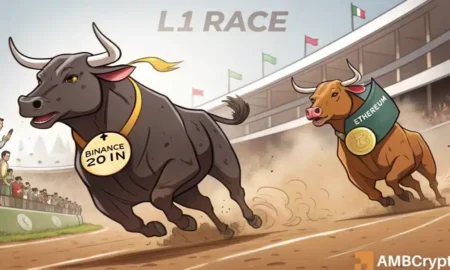Ethereum’s Pectra Upgrade: A Double-Edged Sword?
As Ethereum prepares for its highly anticipated Pectra upgrade, significant questions arise concerning the future of its decentralization and complexity. Vitalik Buterin, co-founder of Ethereum, has expressed concerns that the increasing intricacy of the protocol could lead to risks for both decentralization and accessibility. With the crypto market experiencing stagnation and uncertainty, Ethereum’s substantial developments may come at a cost. In this article, we explore the implications of the Pectra upgrade, the mixed strategies among Ethereum’s whales, and the broader market outlook.
The Pectra Upgrade: Promising Yet Problematic
The Pectra upgrade, considered one of Ethereum’s most transformative enhancements since the Merge, aims to increase blob capacity, simplify validator operations, and implement much-anticipated user experience improvements. However, Buterin’s latest blog post raises an important alarm: the move towards greater complexity could alienate potential contributors and developers. He argues that Ethereum’s evolving architecture is straying from the accessibility that characterized Bitcoin, a stark deviation that might entrench a small group of highly technically skilled contributors. This shift raises crucial concerns about the long-term implications for decentralization—a principle that many in the community hold dear.
Moreover, Buterin emphasizes that simplicity should be a core value alongside decentralization. While the upgrades may add polish to the protocol, the risk of overcomplicating Ethereum exists, raising the question: is the network building a future grounded on sound engineering principles, or could it be a precarious tower built on sand?
Whales in a Sea of Uncertainty
As discussions surrounding the Pectra upgrade unfold, Ethereum whales—those holding large quantities of ETH—are displaying a complex range of investment strategies. This behavior reveals an underlying uncertainty about the network’s direction and future pricing. Recent on-chain data illustrates a poker-like atmosphere as major holders adapt to market conditions rather than demonstrating steadfast confidence.
For instance, one whale recently purchased 3,029 ETH at approximately $1,895, but that investment is now down $142,000. While the same wallet has made profits of $300,000 by strategically buying the dips, such moves do not represent a strong commitment to long-term growth. Conversely, two other whales borrowed a combined $5 million in USDC to purchase ETH, signifying an attempt at bullish positioning. Amidst this, another major player has taken a short position of 10,000 ETH, which is already underwater by $510,000. This diverging behavior among whales encapsulates the erratic sentiment around the Pectra upgrade.
Historical Patterns of Ethereum Upgrades
Ethereum’s past experiences with major upgrades provide a useful lens to predict how the Pectra upgrade might influence market conditions. Historically, such alterations follow a recurring cycle of anticipation, volatility, and subsequent price adjustment. For instance, the Merge in September 2022 led to an initial drop in ETH’s value, only for it to rebound months later, driven by favorable macroeconomic trends. The Shanghai upgrade in April 2023 allowed for unstaking of ETH, which many feared would lead to increased selling pressure. Interestingly, the market instead rallied by over 10%, showcasing that reactions to technical advancements may diverge from initial expectations.
Although the Pectra upgrade might not generate as much initial buzz as the Merge, it carries significant implications for Ethereum’s scalability and validator experience. As such, historical patterns suggest that the consequences of such upgrades may unfold gradually, allowing for a more measured and meaningful re-evaluation of Ethereum’s market position.
Current Market Sentiment: A Balancing Act
At present, ETH is trading around $1,846, exhibiting muted volatility with a relative strength index (RSI) around 58. While the moving average convergence divergence (MACD) indicates nascent bullish momentum, the overall market remains uncertain. Ethereum’s current fundamentals show improvement, yet anxiety about its rising complexity creates a paradoxical environment.
This indecisive motion in price, characterized by minimal movement, could signify a compression phase, whether as a precursor to a significant breakout or as the start of a prolonged consolidation period. The mixed responses from whales also underline the lack of a clear trajectory for ETH in the wake of the Pectra upgrade.
Conclusion: Moving Forward with Caution
As Ethereum navigates its most significant upgrade to date, the dual pressures of complexity and decentralization demand careful attention. Vitalik Buterin’s concerns serve as a crucial reminder for both developers and investors alike: striking the right balance between added functionalities and maintaining accessibility is key to sustaining Ethereum’s health. Mixed signals from whale activity further highlight an uncertain market sentiment that could shape the future of ETH.
In light of Ethereum’s historical tendencies and current challenges, stakeholders must remain vigilant. While the Pectra upgrade seeks to enhance the protocol’s capabilities, its long-term implications on community involvement and market stability are yet to be fully understood. As we step into this new chapter, Ethereum must strive for a balance that honors its foundational ideals of decentralization while embracing the complexities of technological evolution.

















